
Recommended Reading List 4
Leadership - To understand how the Pacific war strategy developed and how the war was won, you need to understand the leaders who planned the strategy and fought the battles. This is the story of perhaps the greatest admirals that the U.S. Navy has ever produced.
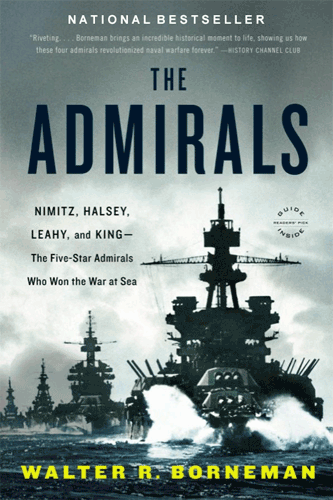
The Admirals: Nimitz, Halsey, Leahy, and King--The Five-Star Admirals Who Won the War at Sea
Walter R. Boreneman
How history's only five-star admirals triumphed in World War II and made the United States the world's dominant sea power.
Only four men in American history have been promoted to the five-star rank of Admiral of the Fleet: William Leahy, Ernest King, Chester Nimitz, and William Halsey. These four men were the best and the brightest the navy produced, and together they led the U.S. navy to victory in World War II, establishing the United States as the world's greatest fleet.
In THE ADMIRALS, award-winning historian Walter R. Borneman tells their story in full detail for the first time. Drawing upon journals, ship logs, and other primary sources, he brings an incredible historical moment to life, showing us how the four admirals revolutionized naval warfare forever with submarines and aircraft carriers, and how these men-who were both friends and rivals-worked together to ensure that the Axis fleets lay destroyed on the ocean floor at the end of World War II.
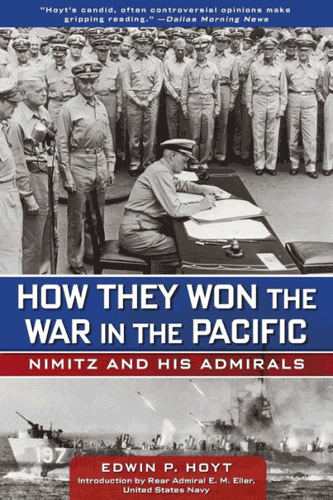
How They Won the War in the Pacific: Nimitz And His Admirals
Edwin Hoyt
This meticulous study is a concentrated look at Naval Admiral Chester W. Nimitz and his subordinate leaders—fighting men under stress—and the relationship of fighting admirals to their top leaders and each other. Bull Halsey, “The Patton of the Pacific,” could win a battle; ascetic and cultivated Raymond Spruance could win a campaign; but Chester W. Nimitz, the quiet but dauntless battler from the banks of the Pedernales River, could win a war. And the way he did win that war in the Pacific is the center of this excellent and absorbing biography of naval operations and of men in command relationships.
How They Won the War in the Pacific covers many leaders, including the top fighting ones afloat and ashore, and it shows Admiral Chester W. Nimitz as history will record him—as the wise, calm tower of strength in adversity and success, the principal architect of victory in the Pacific during World War II.
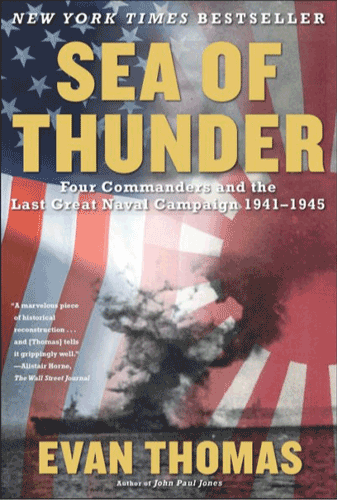
Sea of Thunder: Four Commanders and the Last Great Naval Campaign 1941-1945
Evan Thomas
Admiral Bill Halsey was an American hero, but he was also subject to all our human foibles. He was certainly brave, and never fled from a fight. But at the Battle of Leyte Gulf, he did make a terrible mistake. He wanted one thing above all else, he wanted to sink Jap carriers.That was his undoing in that battle, he was blinded by Admiral Ozawa's empty carriers, and almost created a military disaster. But for Japanese indecision, it could have been a disaster. Admiral Takeo Kurita unwittingly helped to save Admiral Halsey from his own mistake. He could have won a great victory over the U.S. forces at Leyte Gulf, but for unknown reasons he turned his ships around, when they were in sight of victory. No acceptable reason was ever given for his retreat. Admiral Ugaki, served in the shadow of fleet Admiral Yamamoto, until his death in 1943. He was very angry with Admiral Kurita's abrupt retreat at Leyte Gulf. He finally achieved the desire of all Samurai, when he died in a Kamikase raid. He definitely showed the Samurai spirit in hsi actions. Commander Ernest Evans may well have been the most patriotic and the bravest of all four commanders. The selfless decision to confront Admiral Kurita's powerful fleet, knowing that he would not survive the battle, was the bravest act of all. He could have retreated, as Admiral Kurita did, but instead he choose the danger. You can't heip but feel incredible respect for this brave man.
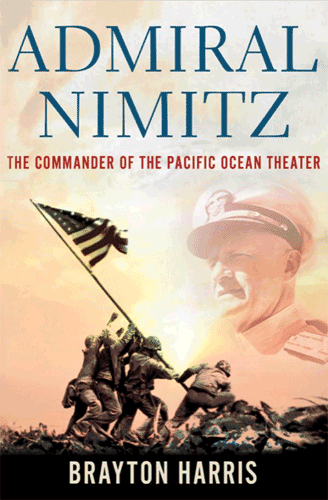
Admiral Nimitz: The Commander of the Pacific Ocean Theater
Brayton Harris
Chester Nimitz was an admiral's Admiral, considered by many to be the greatest naval leader of the last century. After the attack on Pearl Harbor, Nimitz assembled the forces, selected the leaders, and - as commander of all U.S. and Allied air, land, and sea forces in the Pacific Ocean - led the charge one island at a time, one battle at a time, toward victory. A brilliant strategist, he astounded contemporaries by achieving military victories against fantastic odds, outpacing more flamboyant luminaries like General Douglas MacArthur and Admiral "Bull" Halsey. And he was there to accept, on behalf of the United States, the surrender of the Japanese aboard the battleship USS Missouri in August 1945. In this first biography in over three decades, Brayton Harris uses long-overlooked files and recently declassified documents to bring to life one of America's greatest wartime heroes.
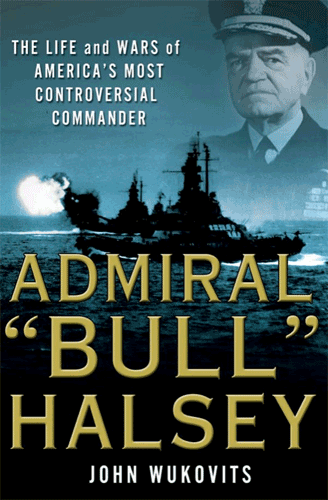
Admiral "Bull" Halsey: The Life and Wars of the Navy's Most Controversial Commander
John Wukovitz
The definitive biography of America's best-known naval officer, who commanded the legendary fast carrier force during WWII.
From the tragic aftermath of Pearl Harbor, when he fashioned America's first response to the attack, to the war's final day in Tokyo Bay when he witnessed Japan's surrender, Admiral William F. Halsey stamped a mighty imprint on the Pacific during World War II. He led or participated significantly in the Navy's first offensive strikes against the Marshall Islands and Wake Island, the Guadalcanal campaign, and the offensive toward Japan. As a commander, he never shied from engaging the enemy, but boldly entered into battle, ready for a fight. As a consequence, Halsey became the face of the Navy and its most attractive public relations phenomenon. Due to his bold tactics and quotable wit, Halsey continues to be a beloved and debated figure.
In this balanced biography, historian John Wukovits illuminates the life of a man who ultimately deserves recognition as one the great naval commanders in U.S. history. Europe had Patton; the Pacific had Admiral William "the Bull" Halsey.
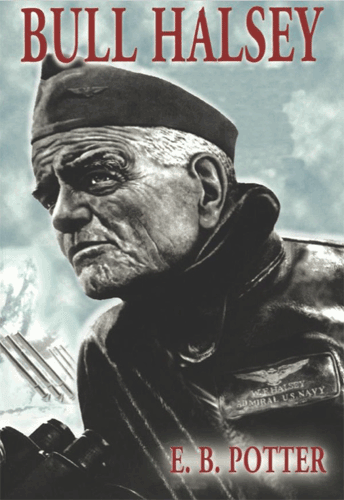
Bull Halsey
E.B. Potter
Traces the life of Admiral William F. Halsey and examines his actions as the leader of the American forces in the South Pacific during World War II.
By the author of Nimitz, this is the first comprehensive biography of Admiral William F. Halsey, the best-known American naval hero of World War II. Drawing on unpublished memoirs, oral histories, and interviews with relatives and military colleagues, Potter has constructed a scholarly and highly readable account of the life of this colorful, bold, controversial leader. The last of the great swashbuckling sea dogs, Halsey was one of the key figures in the defeat of Japan. His strategical decisions during the Battle for Leyte Gulf, however, have been debated for over 70 years. Here the issue is explained with clarity, and readers can draw their own conclusions. Halsey was the only military man of comparable rank who was able to work harmoniously with Douglas MacArthur. Potter not only explains why this was so but provides new material on that increasingly maligned general in his account of the Halsey-MacArthur partnership during the South Pacific campaign.
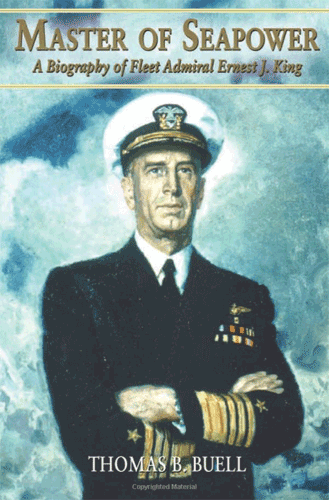
Master of Seapower: A Biography of Fleet Admiral Ernest J. King
Thomas B. Buell
Master of Seapower is a comprehensive biography of the most powerful naval officer in the history of the United States, Ernest J. King, the architect of the American victory in the Pacific. "He was meaner than hell," commented one junior officer, reflecting the general opinion that King was as much despised as he was respected. This didn't seem to bother him, though. Love observed that he "seemed almost to pride himself on the fact that he had earned his rank solely on his merits as a professional naval officer, rather than as a result of the friendship of others."
In the early months of 1942, King's strategic brilliance earned him the complete confidence of President Roosevelt. When none of the British or American war planners even dared to think of going on the offensive in the Pacific in 1942-43, King successfully lobbied to do just that. "No fighter ever won his fight by covering up -- merely fending off the other fellow's blows," he wrote. "The winner hits and keeps on hitting even though he has to be able to take some stiff blows in order to keep on hitting." It's easy to see why even those who despised Ernest King were glad he was on their side.
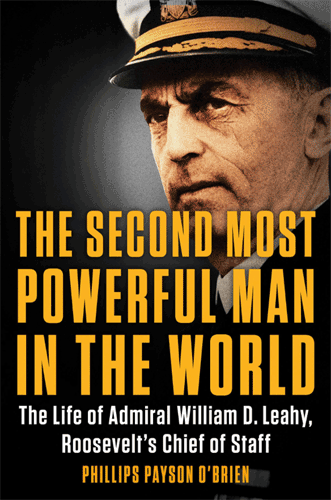
The Second Most Powerful Man in the World: The Life of Admiral William D. Leahy, Roosevelt's Chief of Staff
Phillips Payson O'Brien
Aside from FDR, no American did more to shape World War II than Admiral William D. Leahy--not Douglas MacArthur, not Dwight Eisenhower, and not even the legendary George Marshall. No man, including Harry Hopkins, was closer to Roosevelt, nor had earned his blind faith, like Leahy. Through the course of the war, constantly at the president's side and advising him on daily decisions, Leahy became the second most powerful man in the world.
Needing one person who could help him grapple with the enormous strategic consequences of the war both at home and abroad, President Roosevelt made Leahy the first presidential chief of staff--though Leahy's role embodied far more power than the position of today.
Leahy's profound power was recognized by figures like Stalin and Churchill, yet historians have largely overlooked his role. In this important biography, historian Phillips Payson O'Brien illuminates the admiral's influence on the most crucial and transformative decisions of WWII and the early Cold War. From the invasions of North Africa, Sicily, and France, to the allocation of resources to fight Japan, O'Brien contends that America's war largely unfolded according to Leahy's vision. Among the author's surprising revelations is that while FDR's health failed, Leahy became almost a de facto president, making decisions while FDR was too ill to work, and that much of his influence carried over to Truman's White House.
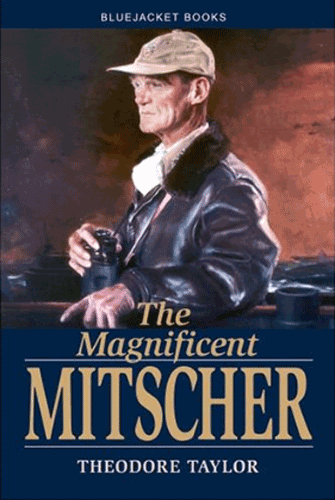
The Magnificent Mitscher
Theodore Taylor
Air Admiral Marc Mitscher, who led the U.S. attack across the Pacific, is a legend in military circles for developing an entirely new concept of war at sea. His skills as a carrier tactician and genius for leading men rank him with the best World War II combat commanders, yet because he shunned publicity and destroyed his private papers shortly before his death in 1947, his accomplishments are not widely known. Mitscher's sound decisions and successful tactics helped create the greatest striking weapon in history--the carrier force that could put up a thousand planes in half an hour, the task force that sank a thousand ships and destroyed the Japanese air force, the fleet that opened a direct route to Japan.
Written by a former naval officer and well-known journalist, this book tells the full story of this pioneer of naval aviation and his innovations. Theodore Taylor traces the aviator's brilliant career from its beginnings in 1916, when Mitscher became one of the Navy first pilots. When first published in 1954, it was hailed as a first-class biography that set down the major role played by the admiral in developing the Navy's air program, and is also credited with providing a lively and detailed history of the progress of naval aviation. The author accomplishes all this with compassion, humor, and deep respect for his subject.
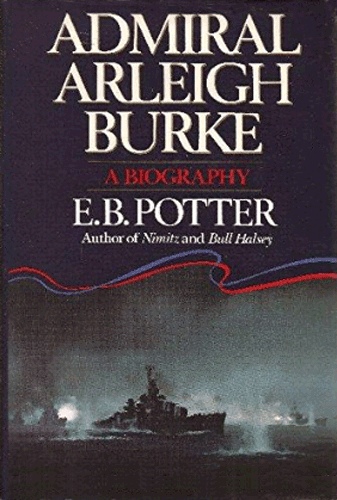
Admiral Arleigh Burke
E. B. Potter
One of the military's most colorful figures, and the last surviving WW II naval commander, "31-Knot Burke" was a destroyer captain in the Solomons campaign, served as Admiral Marc Mitscher's chief of staff in the final two years of the war and, in 1955, was chosen over 91 senior admirals as Chief of Naval Operations. Retiring after four decades of active service in 1961, Burke became co-founder and director of the Center for Strategic and International Studies at Georgetown University. Potter, former chairman of naval history at the U.S. Naval Academy, has written an entertaining biography of a talented and resourceful officer who was instrumental in the development of the missile-armed, nuclear-propelled navy. Of particular interest is Potter's clarifying account of the controversy over unification of the armed services in the late 1940s and Burke's role in the so-called "Revolt of the Admirals."
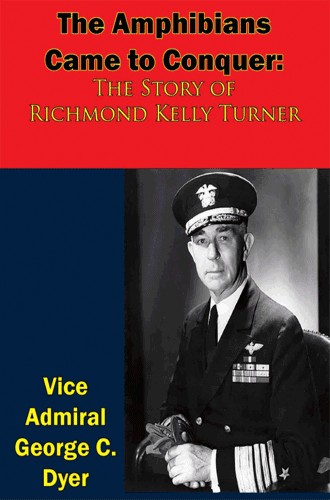
The Amphibians Came to Conquor: The Story of Admiral Richmond Kelly Turner
George Carroll Dyer (Vice Admiral, USN, Rt.)
His nickname was "Terrible Turner." He was, according to one ensign who served with him prior to World War II, "the meanest man I ever saw, and the most competent naval officer I ever served with." He led the successful amphibious attacks on Guadalcanal, Makin, Kwajalein, Roi-Namur, Saipan, Tinian, and Guam. He was Admiral Richmond Kelly Turner, one of the key figures in America's defeat of Japan. In this fascinating and comprehensive biography, Vice Admiral George C. Dyer documents the tough and fearless leadership of Admiral Turner, his astonishing success in meeting some of the toughest challenges in the history of amphibious warfare, and detailed descriptions of the ships and men who fought under him.
More than just a biography, The Amphibians Came to Conquer is a carefully documented history, both strategic and tactical, of the major campaigns in the Pacific from Guadalcanal to Okinawa, providing a wealth of information on how Terrible Turner and the men he commanded conquered island after island against a tough and determined foe. In an astonishing tribute to the tenacity of Turner and his men, a February 21, 1945 Japanese broadcast said: "The true nature of an alligator is that once he bites into something, he will not let go. Turner's nature is also like this." This remarkable book belongs in the library of any serious student of the war in the Pacific.
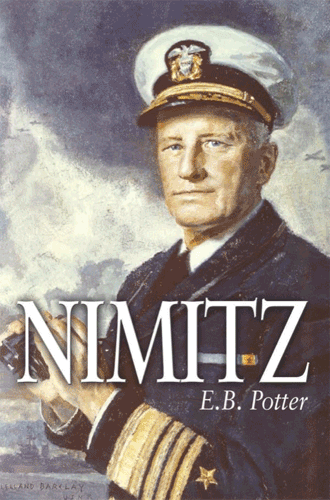
Nimitz
E. B. Potter
Called a great book worthy of a great man, this definitive biography of the commander in chief of the Pacific Fleet in World War II, first published in 1976 and now available in paperback for the first time, continues to be considered the best book ever written about Adm. Chester W. Nimitz. Highly respected by both the civilian and naval communities, Nimitz was sometimes overshadowed by more colorful warriors in the Pacific such as MacArthur and Halsey.
Potter's lively and authoritative style fleshes out Admiral Nimitz's personality to help readers appreciate the contributions he made as the principal architect of Japan's defeat. Following the Japanese attacks on Pearl Harbor on 7 December 1941, President Roosevelt named Nimitz as commander of the Pacific Fleet. An experienced and respected leader, Nimitz was also an effective military strategist who directed U.S. forces as they closed in on Japan, beginning in May and June of 1942 with the battles of the Coral Sea and Midway. Nimitz was promoted to the newly-created rank of fleet admiral in 1944 and became the naval equivalent to the army's General Dwight Eisenhower. The book covers his full life, from a poverty-stricken childhood to postwar appointments as Chief of Naval Operations and U.N. mediator. It candidly reveals Nimitz's opinions of Halsey, Kimmel, King, Spruance, MacArthur, Forrestal, Roosevelt, and Truman.

